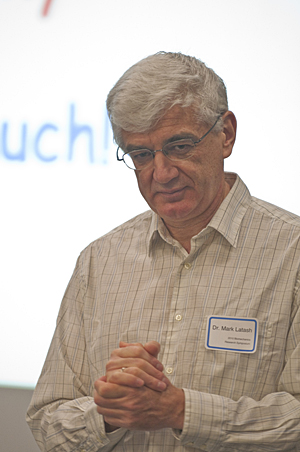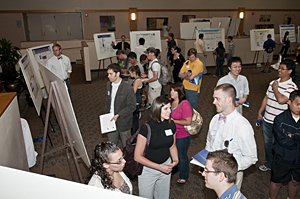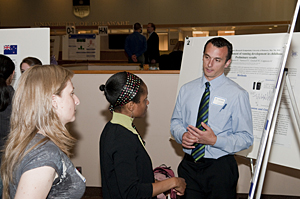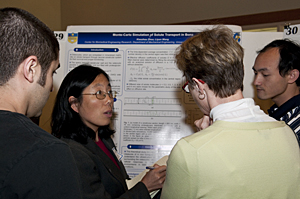ADVERTISEMENT
- Rozovsky wins prestigious NSF Early Career Award
- UD students meet alumni, experience 'closing bell' at NYSE
- Newark Police seek assistance in identifying suspects in robbery
- Rivlin says bipartisan budget action, stronger budget rules key to reversing debt
- Stink bugs shouldn't pose problem until late summer
- Gao to honor Placido Domingo in Washington performance
- Adopt-A-Highway project keeps Lewes road clean
- WVUD's Radiothon fundraiser runs April 1-10
- W.D. Snodgrass Symposium to honor Pulitzer winner
- New guide helps cancer patients manage symptoms
- UD in the News, March 25, 2011
- For the Record, March 25, 2011
- Public opinion expert discusses world views of U.S. in Global Agenda series
- Congressional delegation, dean laud Center for Community Research and Service program
- Center for Political Communication sets symposium on politics, entertainment
- Students work to raise funds, awareness of domestic violence
- Equestrian team wins regional championship in Western riding
- Markell, Harker stress importance of agriculture to Delaware's economy
- Carol A. Ammon MBA Case Competition winners announced
- Prof presents blood-clotting studies at Gordon Research Conference
- Sexual Assault Awareness Month events, programs announced
- Stay connected with Sea Grant, CEOE e-newsletter
- A message to UD regarding the tragedy in Japan
- More News >>
- March 31-May 14: REP stages Neil Simon's 'The Good Doctor'
- April 2: Newark plans annual 'wine and dine'
- April 5: Expert perspective on U.S. health care
- April 5: Comedian Ace Guillen to visit Scrounge
- April 6, May 4: School of Nursing sponsors research lecture series
- April 6-May 4: Confucius Institute presents Chinese Film Series on Wednesdays
- April 6: IPCC's Pachauri to discuss sustainable development in DENIN Dialogue Series
- April 7: 'WVUDstock' radiothon concert announced
- April 8: English Language Institute presents 'Arts in Translation'
- April 9: Green and Healthy Living Expo planned at The Bob
- April 9: Center for Political Communication to host Onion editor
- April 10: Alumni Easter Egg-stravaganza planned
- April 11: CDS session to focus on visual assistive technologies
- April 12: T.J. Stiles to speak at UDLA annual dinner
- April 15, 16: Annual UD push lawnmower tune-up scheduled
- April 15, 16: Master Players series presents iMusic 4, China Magpie
- April 15, 16: Delaware Symphony, UD chorus to perform Mahler work
- April 18: Former NFL Coach Bill Cowher featured in UD Speaks
- April 21-24: Sesame Street Live brings Elmo and friends to The Bob
- April 30: Save the date for Ag Day 2011 at UD
- April 30: Symposium to consider 'Frontiers at the Chemistry-Biology Interface'
- April 30-May 1: Relay for Life set at Delaware Field House
- May 4: Delaware Membrane Protein Symposium announced
- May 5: Northwestern University's Leon Keer to deliver Kerr lecture
- May 7: Women's volleyball team to host second annual Spring Fling
- Through May 3: SPPA announces speakers for 10th annual lecture series
- Through May 4: Global Agenda sees U.S. through others' eyes; World Bank president to speak
- Through May 4: 'Research on Race, Ethnicity, Culture' topic of series
- Through May 9: Black American Studies announces lecture series
- Through May 11: 'Challenges in Jewish Culture' lecture series announced
- Through May 11: Area Studies research featured in speaker series
- Through June 5: 'Andy Warhol: Behind the Camera' on view in Old College Gallery
- Through July 15: 'Bodyscapes' on view at Mechanical Hall Gallery
- More What's Happening >>
- UD calendar >>
- Middle States evaluation team on campus April 5
- Phipps named HR Liaison of the Quarter
- Senior wins iPad for participating in assessment study
- April 19: Procurement Services schedules information sessions
- UD Bookstore announces spring break hours
- HealthyU Wellness Program encourages employees to 'Step into Spring'
- April 8-29: Faculty roundtable series considers student engagement
- GRE is changing; learn more at April 15 info session
- April 30: UD Evening with Blue Rocks set for employees
- Morris Library to be open 24/7 during final exams
- More Campus FYI >>
1:18 p.m., May 10, 2010----Mark Latash is so fascinated by the concept of synergy that he has written an entire book on the use of the term in reference to biological systems.
On Friday, May 7, he shared some of his most recent findings on the role played by synergies in the control and coordination of human movement at the 7th annual Biomechanics Research Symposium at the University of Delaware. The event was organized and hosted by UD's Center for Biomedical Engineering Research (CBER).
Distinguished Professor of Kinesiology at Penn State University, Latash was the keynote speaker at the conference, which attracted more than 130 people from UD's biomechanics community.
His talk, “Multi-Digit Synergies: Effects of Age and Fatigue,” addressed his development of a powerful new tool to study changes in coordination that accompany impaired performance with age, fatigue, and potentially other causes as well.
Aging, he said, is associated with a shift in control from synergic, where the parts of the body work together, to somatotopic, where they are more like free agents. “In effect,” Latash said, “as we age, we become 'young' again, where our actions are more like the somewhat aimless movements of a baby.
“Interestingly, aging brings with it better element-based control, where, for example, one finger is enlisted to do a task on its own, but our performance on things that require synergies worsens as we get older.”
Latash's studies of fatigue have also turned up some surprising results. He carried out a study to determine what happens to multi-finger synergies when one finger gets tired.
“The weakest link theory would suggest that the entire performance would suffer from the fatigue of that one finger,” Latash said. “But what we found is that with fatigue, synergies become better. This is not a trivial finding.”
He likened the situation to four men carrying a heavy piano up several flights of stairs. If one of the four becomes tired and starts to wobble in his hold on the piano, he can be asked to step aside while the other three continue with the task, reducing the manpower by a fourth. However, in Latash's scenario, the other three can compensate with similar but complementary movements, enabling the task to continue with almost no loss in the quality of the performance.
“Dr. Latash is the most recent in a long line of distinguished keynote speakers at our research symposia,” said Jill Higginson, assistant professor of mechanical engineering and CBER director. “His research on the control and coordination of human voluntary movements has implications for our studies on stroke, arthritis, running, motor control, and modeling.”
In addition to Latash's talk, the program featured 10 student podium presentations and 45 research posters. Latash joined six UD faculty members as judges in a competition to choose the top two in each category. Winners were as follows:
Podium Presentations
Stephanie Di Stasi, “Perturbation Training Improves Gait Patterns in ACL-Deficient Females.”
Deepak Kumar, “Articular Loading in People with Knee Osteoarthritis.”
Posters
Trisha Kesar, “Cortical Motor Mapping in Cerebral Palsy.”
Vincent Baro, “Biomechanical Responses of the Meniscus to Contact Loading.”
Attendees represented a broad array of disciplines at UD, including mechanical engineering, physical therapy, electrical engineering, biology, kinesiology and applied physiology, materials science, chemical engineering, and physics, as well as UD's Biomechanics and Movement Sciences (BIOMS) graduate program.
Article by Diane Kukich
Photos by Doug Baker






